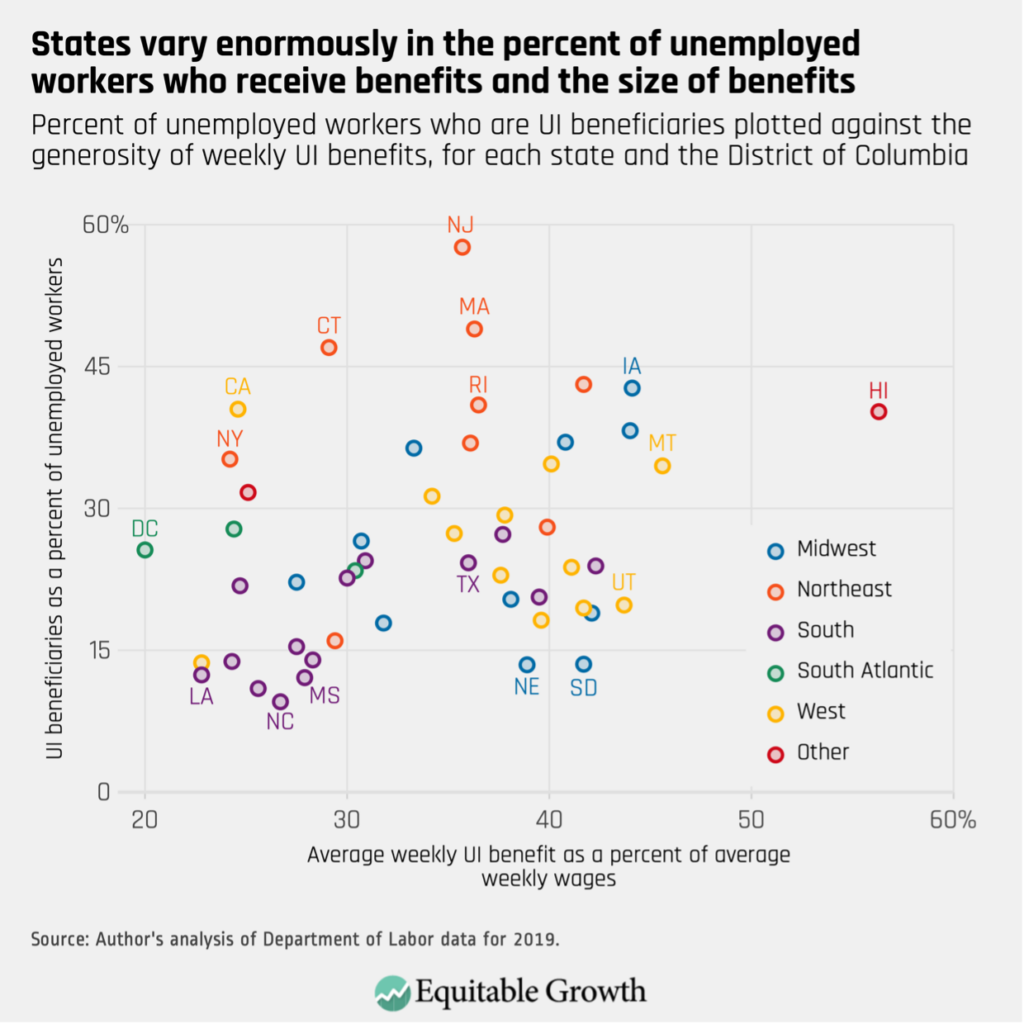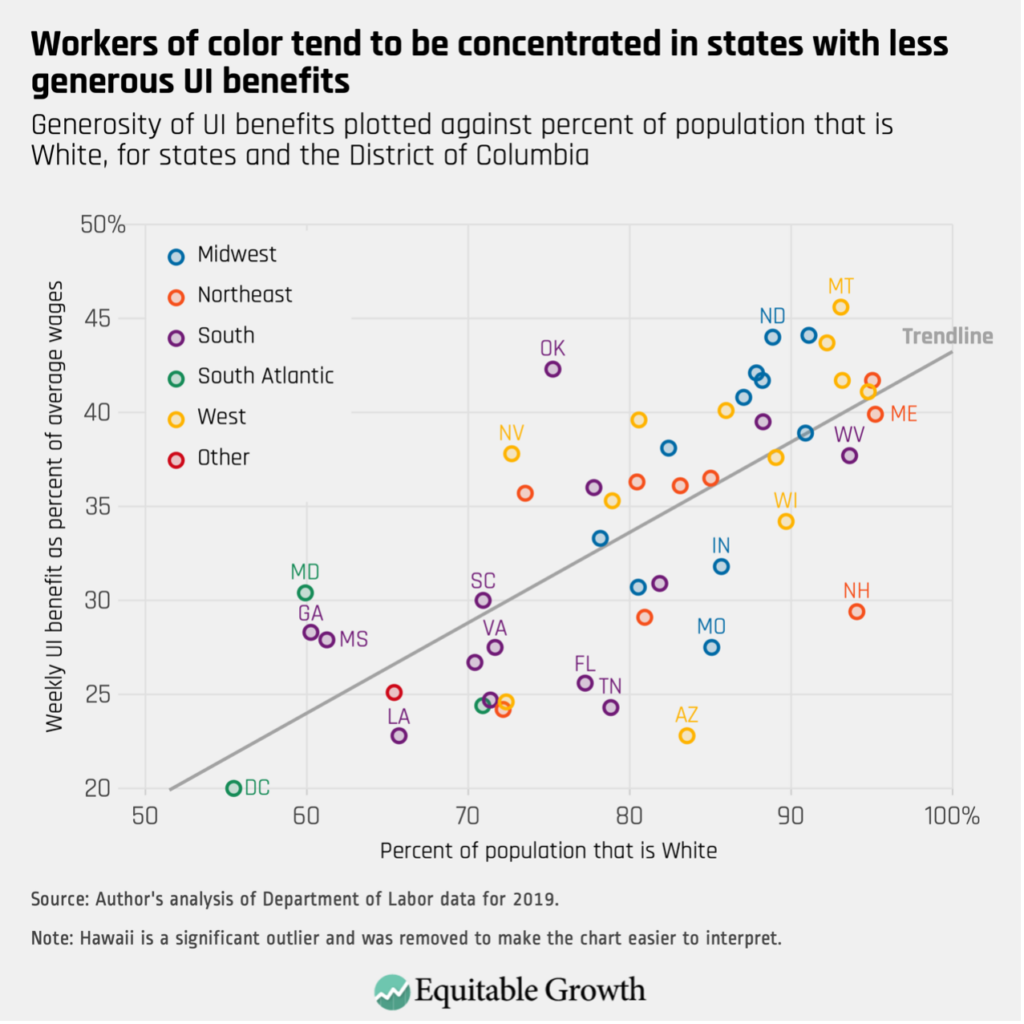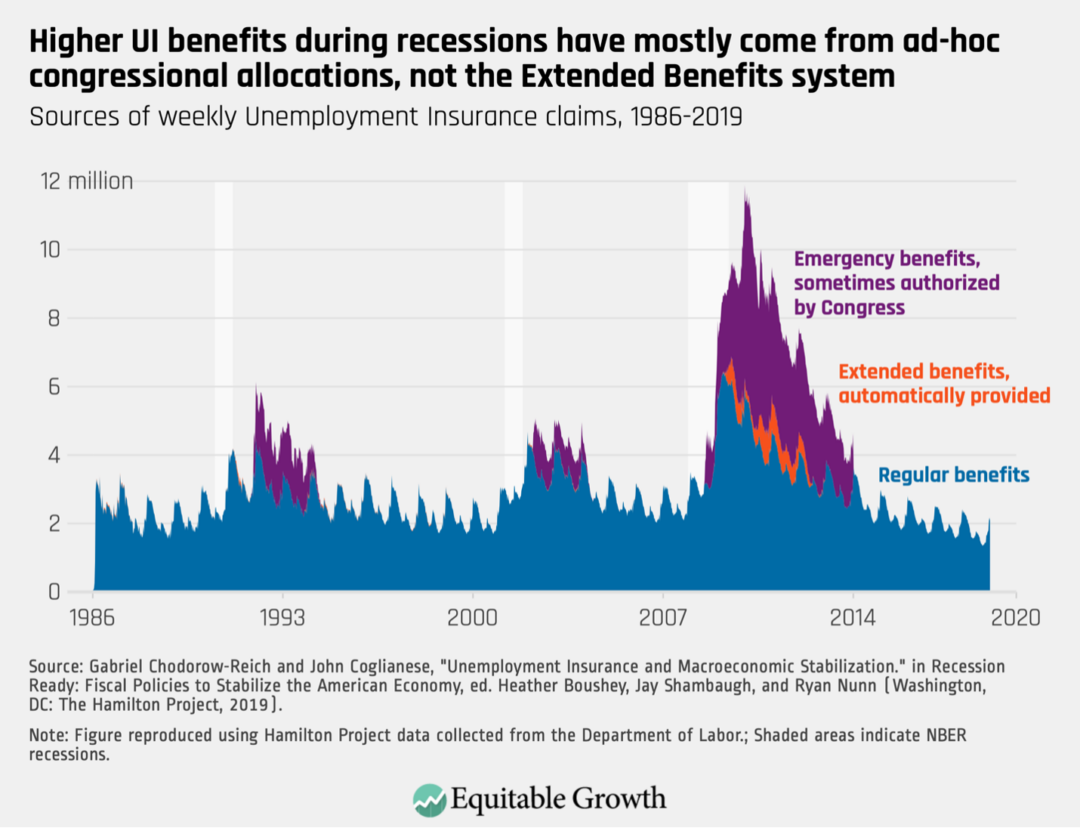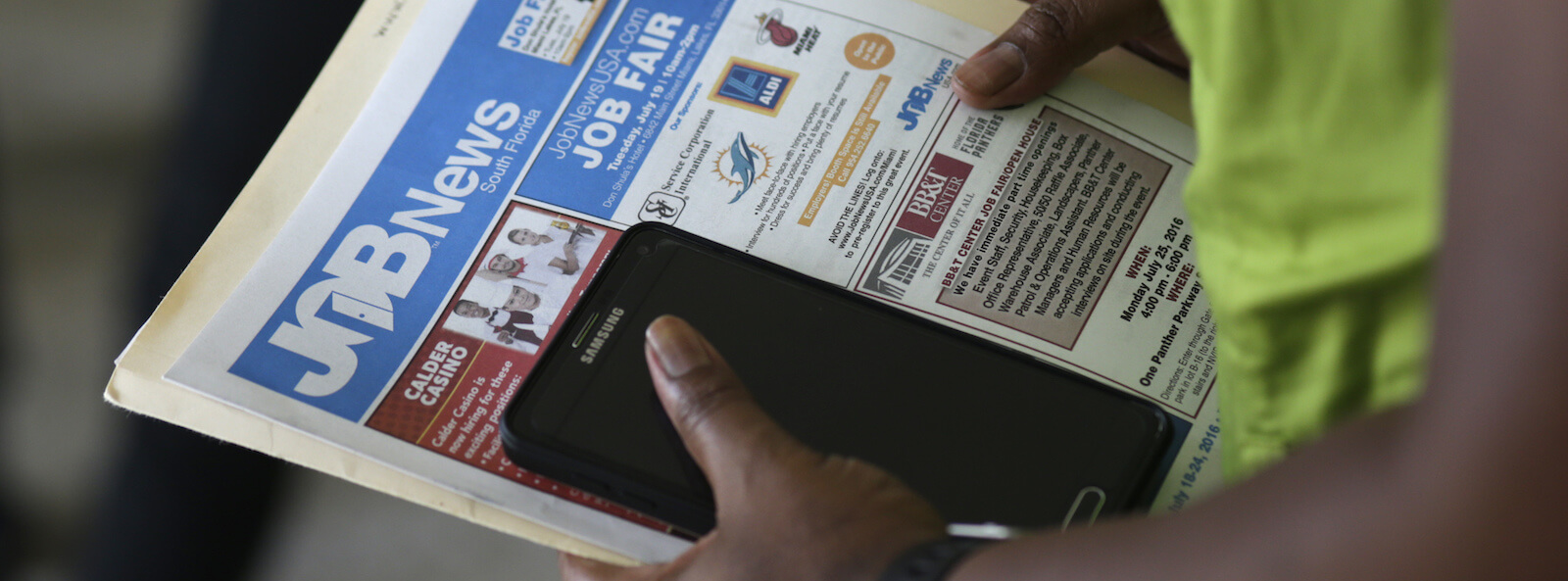An Unemployment Insurance modernization bill now before the U.S. Senate is a much-needed step in the right direction

The nearly 90-year-old federal-state Unemployment Insurance program provides much-needed relief to unemployed workers who lose their jobs through no fault of their own and helps to stabilize the U.S. economy during downturns. Through 14 recessions since its enactment as part of the New Deal, most recently the Great Recession of 2007–2009 and the short but sharp COVID-19 recession in 2020, this pivotal income support program remains a cornerstone of our nation’s social infrastructure.
Yet despite its strengths, the UI system falls short in serious ways. New U.S. Senate legislation—the Unemployment Insurance Modernization and Recession Readiness Act of 2023—would take important steps toward bolstering the system and ensuring that it can adequately support workers and the economy as a whole amid future recessions. In particular, the bill works toward addressing states’ race-to-the-bottom in terms of the amount of income support provided and the number of workers reached, while also advancing racial equity, bolstering the system’s responsiveness to recessions, and more effectively supporting vulnerable workers looking for jobs.
The new legislation builds in part upon lessons learned during the COVID-19 pandemic. The U.S. Census Bureau estimates that UI benefits kept nearly 5 million people, including more than 1 million children, out of poverty. In addition, those workers who received these benefits helped lower their material insecurity and hardship, and they reported fewer difficulties meeting household expenses, fewer times experiencing food insecurity, and lower anxiety and depression, compared to families that applied for Unemployment Insurance but did not receive these benefits.
As a result, macroeconomic analysts agree that economic output was higher and unemployment was lower as a result of the greater consumption that UI benefits supported during the COVID-19 pandemic. Still, the Unemployment Insurance program needs to be updated to meet the needs of workers and their families and the broader U.S. economy in the 21st century.
This column considers three of the most important changes the new Senate bill proposes to make to the UI system, detailing the extensive impact each would have for workers and to bolster the U.S. economy during downturns. These include:
- Creating new minimum standards for UI benefits
- Repairing the automatic system of extended benefits during recessions
- Launching a new jobseekers allowance for workers who do not qualify for traditional UI benefits but who need support while looking for work
Together, these reforms would make the Unemployment Insurance system more effective at meeting the needs of workers and the economy because they are based on the latest evidence-driven data and analysis. So, let’s turn first to the need for national standards for UI benefits.
Creating national standards for UI benefits
The Unemployment Insurance system is run as a partnership between the federal government and states, the District of Columbia, and territories, with state and territorial partners largely left on their own to set rules about which workers qualify, the level of income support provided, and how long workers can claim UI benefits. While there have always been important differences across states in the amount of UI income support and eligibility, since the Great Recession, a number of states have introduced dramatic cuts to their benefits.
Ten states halved the maximum number of weeks a worker could claim benefits. This has made it substantially harder for workers to gain access to benefits. And, because these cuts have happened in states with large workforces of color, Black, Hispanic, and other non-White workers have tended to bear the brunt of these cuts.
Indeed, pre-pandemic data from 2019 show that there is dramatic variation across states in both the average level of income support that workers can expect to receive, as well as the percentage of unemployed workers who claim benefits. In some states, such as North Carolina, Florida, Tennessee, Arizona, and Louisiana, UI benefits replace less than 15 percent of average weekly wages and less than 30 percent of unemployed workers actually receive benefits. These stingy systems create more economic hardship for workers their families and make it harder for the UI system to boost the economy during recessions. (See Figure 1.)
Figure 1

The stingiest states also tend to be the states with the largest workforces of color, exacerbating racial inequalities in the level of UI benefits. (See Figure 2.)
Figure 2

The new Senate legislation would address this race-to-the-bottom dynamic head-on, requiring for the first time that states offer at least 26 weeks of UI benefits, that those benefits replace at least 75 percent of workers’ wages, and that the maximum amount of income support must equal at least two-thirds of each state’s average weekly wage.
Together, these changes would mean that every state would offer at least a minimum baseline of Unemployment Insurance support to all eligible workers. This would ensure that the UI system provides more relief to unemployed workers, helping them and their families meet their basic needs. In so doing, it would also improve the ability of the UI system to inject more stimulus into the economy during recessions, by helping support consumption among unemployed workers and their families. And, by preventing some states, especially Southern and Southwestern states, from drastically curbing their income support levels, it would help address racial disparities between workers in access to UI benefits across states.
Fixing the Automatic Extended Benefits System
During a recession, economists agree that Unemployment Insurance support should be increased because more people are unemployed for longer periods of time. In 1970, Congress created a permanent system of Extended Benefits to offer between 13 and 20 additional weeks of benefits to workers in states with high unemployment rates who had exhausted their regular state benefits. These extended weeks of UI benefits “trigger on” when states hit certain thresholds, providing more weeks for workers in states with higher levels of unemployment.
Despite these aims, the Extended Benefit system has played a remarkably small role in responding to recessions in recent decades. Just 2 percent of those who received Unemployment Insurance did so through the Extended Benefits program from 1986 through 2023. In fact, higher UI benefits during recessions have come from emergency, ad-hoc benefits passed by Congress, not through the automatic Extended Benefits system. (See Figure 3.)
Figure 3

The reason is that states use “triggers” that are flawed to turn on Extended Benefits, which means they are unresponsive to changes in state economies and national economic conditions. There are three especially significant flaws in the triggers states use.
First, many states use a trigger based not on their state’s unemployment rate but rather on the proportion of workers receiving UI benefits. That means these states’ triggers are affected not just by labor market conditions but also by the stinginess of the state’s UI benefits. Stingier states where fewer workers qualify for benefits in the first place are less likely to trigger on during a downturn—and as more states cut UI benefits, especially in terms of the weeks of benefits, fewer states are likely to trigger on, even during a recession.
Second, the triggers are state-specific and are thus not responsive to a national downturn or a downturn in a high unemployment region. This flaw weakens the macroeconomic stabilization that Extended Benefits can bring when there is a recession spreading across multiple states.
Third, the triggers can frequently turn off if there has been no significant increase in unemployment over the prior 2 years. As a result, if unemployment remains high, then Extended Benefits may turn off even though the need has not diminished.
The proposed Senate legislation makes a number of important fixes to Extended Benefits to address these three issues. These include moving states away from relying only on measures of UI recipiency to measures based on each state’s unemployment rate. This means the stinginess of individual state UI eligibility requirements would not necessarily affect the availability of Extended Benefits.
The proposed legislation also builds in triggers for both state and national unemployment rates so that the system can be responsive to national or regional downturns—not just a state’s own unemployment rate. This provision captures the interconnected nature of the U.S. economy across states. And there also are new provisions to keep Extended Benefits triggered on when unemployment is high but not increasing, so that benefits keep flowing during sustained recessions.
Creating a new jobseekers allowance
The proposed legislation also takes a very important step forward in expanding financial support for workers who would not otherwise qualify for regular UI benefits by creating a “jobseekers allowance.” This new provision would create a federal weekly benefit for workers who are actively seeking work but are not covered by Unemployment Insurance or only qualify for very limited income support.
To receive this new jobseekers allowance, workers would need to be able to work, available to work, and actively seeking work, be at least 19 years old or have earned a high school diploma or equivalent, and earn income below a certain threshold.
The proposed jobseekers allowance would provide up to $250 per week and cover workers who experience bouts of unemployment, such as:
- Recent high school or college graduates who are looking for a job but do not have paid work experience
- Family members who left the paid labor force to take care of children or elderly family members and who want to return to work but do not have recent paid work experience
- Individuals who are returning to paid work after time in the criminal justice system and who are looking for a job but do not have recent paid work experience
- Low-paid workers who would not earn enough in UI benefits to support their job searches
A jobseekers allowance would provide vital support to these workers, helping them with weekly income support until they find jobs that are well-matched to their skills, education, and experience. This support could be especially important for otherwise-vulnerable workers, such as individuals who are trying to reenter the labor market after returning from incarceration and who face a number of obstacles in their job searches, as well as young workers entering the labor market for the first time, whose early jobs often set their earnings and employment trajectory for years to come.
Conclusion
Together, these changes to the Unemployment Insurance system in the proposed Senate legislation would help the system better support U.S. workers and respond to economic downturns. Importantly, the changes would help address the striking racial disparities in access to UI benefits across states.
To be sure, there are many other important changes needed in the UI system—for instance, to improve the financing of benefits by ensuring that taxes adequately fund the system. But the proposed Senate legislation offers vital steps forward.
Did you find this content informative and engaging?
Get updates and stay in tune with U.S. economic inequality and growth!






